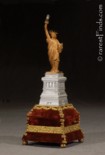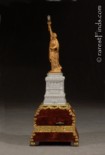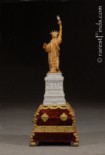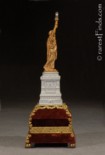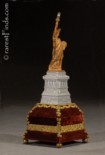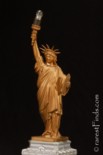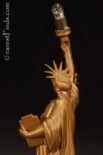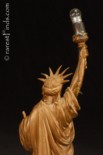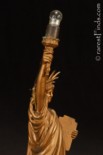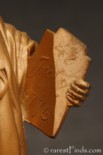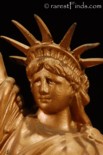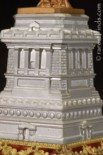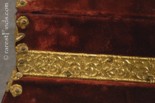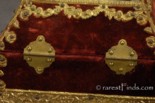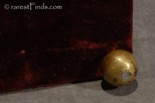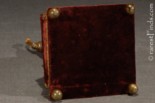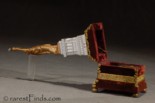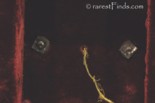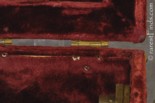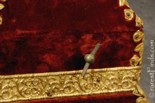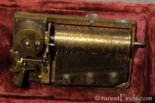The finest Novelty Light extant, the 1898 Ever Ready Statue of Liberty with music box; the only one known! Price, $6,800.
Patents, click on any image to see larger image!

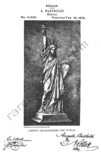
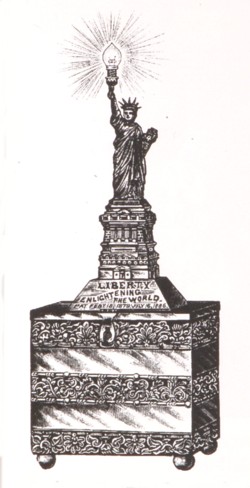
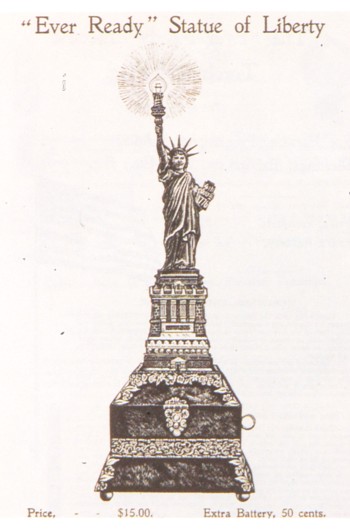
Several improvements were necessary to get to the point where Zinc-Carbon dry-cell batteries were safe and practical to use in portable lights; the last one was German inventor Carl Gassner´s improvement patented under U.S. patent no 373,064, issued on November 15, 1887. This patent date, just one date of the patents issued to Gassner, was printed on the 12 inch version of the Ever Ready Statue of Liberty Novelty Light. Please note image out of the American Electrical Novelty and Manufacturing Co. catalog for the year 1900 shown on the left. Please click on the picture to download a larger image to read the patent date; the patent date is in small letters between the base of the statue and the battery box below. There is a second patent date shown in the same place, the date Feb 18, 1879. This is the date of the design patent issued to Frederic Auguste Bertholdi for his "a statue representing Liberty enlightening the world ...", see images of patent documents above. The patent protected his design for 14 years.
Conrad Hubert 1856 - 1928, founder of EVEREADY, used “Ever Ready” as his brand name for his Novelty Lights in his first catalog which he issued in 1898. The high quality 23 page catalog showed seven Novelty Lights he manufactured in his company “The American Electrical Novelty and Manufacturing Co.”. David Misell, who had invented several early battery powered lights, became Conrad Hubert´s business partner. The American Electrical Novelty and Manufacturing Co. became later on the EVEREADY Co. This first catalog, the catalog of 1989, offered some lights in more then one size, like the Statue of Liberty Novelty Light, which was offered in two sizes; a 12 inch and an 18 inch version. The 12 inch version was offered with or without a music box; the version 18 inches in height was only offered with a music box and was available at a hefty price at the time of $12.50; see picture above to the left and right showing page 14 and 15 of the American Electrical Novelty and Manufacturing Co´s 1898 catalog.
By 1904, the price of the 18 inch version was even higher with a price of $15.00. The Ever Ready Statue of Liberty lights remained in the catalog and was offered for the next five years. It is reasonable to assume that the high price is one of the reasons why not many, if any, were ever made and sold.
But the American Electrical Novelty and Manufacturing Co. was not the only manufacturer offering a Statue of Liberty Novelty Light. Dr. Theodor Birdsall, the founder of Birdsall Electric Manufacturing Co., issued his first catalog two years earlier, in 1896. Overly optimistic, he ordered 100,000 copies of his 34 page catalog in which he also offered a Statue of Liberty Novelty Light. Due to the high price of his Novelty Lights, and the fact that the batteries in his lights turned to junk after just a few weeks, his company never got of the ground. Birdsall´s death during the same year sealed the fate of Birdsall Electric Manufacturing Co.
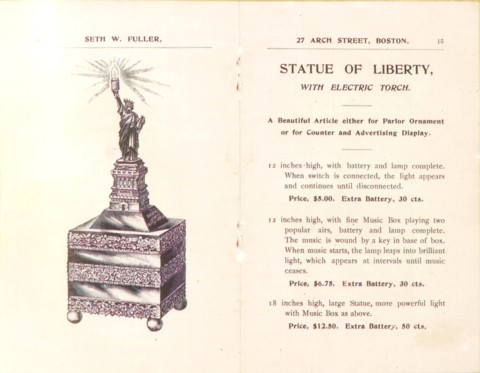 Most of the information offered here is to be found in the very well researched and written book, “FLASHLIGHTS, With Rarity & Value Guide, Early Flashlight Makers & the 1st 100 Years of EVEREADY, by Bill T. Utley.” Utley´s book is considered by many, the “bible” for flashlight collectors. Utley wrote about the Statue of Liberty Novelty lights in his book on page 75:
Most of the information offered here is to be found in the very well researched and written book, “FLASHLIGHTS, With Rarity & Value Guide, Early Flashlight Makers & the 1st 100 Years of EVEREADY, by Bill T. Utley.” Utley´s book is considered by many, the “bible” for flashlight collectors. Utley wrote about the Statue of Liberty Novelty lights in his book on page 75:
“The Birdsall 1896 catalog offered a Statue of Liberty Electric Novelty with the torch illuminated with a bulb powered by a dry cell battery. It was offered with, or without a music box. Conrad Hubert offered a similar novelty in his 1898 Ever Ready catalog. The Statue was continued in Ever Ready catalogs until 1904. Neither Birdsall nor Ever Ready Statues of Liberty have been located to date.”
I contacted Bill Utley after finding this Statue of Liberty Novelty Light and asked him if in the 15 years after publishing his book, one would have been found. His answer was, “I´ve never seen one Peter, so you have the only one that I know of. Congratulations! Bill Utley.”
Stuart Schneider´s book, “COLLECTING FLASHLIGHTS WITH VALUE GUIDE,” shows the 18 inch version of the Statue of Liberty Ever Ready Novelty Light on page 15. The image is from the “American Electrical Novelty and Manufacturing Co.” catalog of the year 1900. See picture on the right. The price noted is $15.
The Statue of Liberty Novelty Light offered here is the larger model, the 19 inch version, with a built in music box. The music box has a comb with 44 teeth or reeds and plays two tunes, see picture #23. On the right hand side of the battery box is a key to wind-up the music box, see picture #22. Fully wound up, the music box plays both tunes about four times.
To hear the music box playing, click here!
This one of a kind Novelty Light embraces the spirit of the time like no other; at the time mechanical music boxes were the only entertainment at home unless you would sing and play an instrument yourself; there was no radio and no television. Electric Light was the fortune of a few who were living in cities. The United States was the dream of many who left their place of origin for different reasons; whether they were suppressed and oppressed or had no way of living a decent life for many other reasons, they left everything behind in search of a better life. They found their way to the promised land of the free and were greeted with this marvelous monument which has not lost its luster after more than a century. I can only imagine their emotions approaching the Statue of Liberty after a long journey where the endless ocean and their expectations was all they had to contend with.
To the best of my knowledge, the Statue of Liberty offered here, is, as of now, the only extant example of this Novelty Light.
Condition:
Considering the delicate nature of the casting and the used Silk Plush material of this rare Novelty Light, the only one extant, is in remarkable state of preservation. All seven of the crown spikes adorning the Statue´s crown are still in place and none are broken or missing! See picture #12. One of the two little brass hinges in the back has some damage, see picture #3 and 16. A little piece with one of the three nail-holes is broken off. A new hole was drilled some time ago and when I found it, the hinges were attached with ugly screws. The screws have been removed and the hinges have been re-attached with vintage brass nails of the correct size, see picture #16. The holes are still visible where the screws were, see picture #21. A little piece of the brass flower and leave garland running up the left corner of the box containing the battery and music box is missing, see pictures #1, 5, and 19. The silk insulated wire connecting the lightbulb with the battery is damaged, see picture #10. The original light-bulb is long gone and replaced with a later bulb, see picture #10.
The paint and all the silk-plush and decoration are original and in remarkable condition. Other then the little flaws described here, there are no repairs or damage at all.
History:
The Statue of Liberty is not just an American Icon, in 1984, the Statue of Liberty was designated a UNESCO World Heritage Site. The UNESCO “Statement of Significance” describes the statue as a “masterpiece of the human spirit” that “endures as a highly potent symbol—inspiring contemplation, debate and protest - of ideals such as liberty, peace, human rights, abolition of slavery, democracy and opportunity.”
The Statue of Liberty is a figure of a robed woman representing Libertas, a Roman liberty goddess. She holds a torch above her head with her right hand, and in her left hand carries a tabula ansata inscribed in Roman numerals with “JULY IV MDCCLXXVI” (July 4, 1776), the date of the U.S. Declaration of Independence. A broken chain lies at her feet as she walks forward. The statue became an icon of freedom and of the United States, its foundation and pedestal were aligned so that it would face southeast, hence, greeting ships entering the harbor from the Atlantic Ocean. The Statue of Liberty was the first site that immigrants arriving on ships in New York harbor from all over the world would see.
The colossal neoclassical sculpture is located on Liberty Island in New York Harbor. A gift from the people of France to the people of the United States, the copper statue was designed by French sculptor Frédéric Auguste Bartholdi and built by Gustave Eiffel, the man who also built the Eiffel Tower in Paris. The statue´s completion was marked by New York´s first ticker-tape parade and a dedication ceremony with a speech by President Grover Cleveland on October 28, 1886.
More than 20 years years earlier, sculptor Bartholdi was inspired to sculpt the monument depicting Liberty by Édouar René de Laboulaye, a French law professor and politician. In the summmer of 1865, the two men had an after dinner conversation. Laboulaye was president of the French Anti-Slavery Society and a prominent and important political thinker of his time. He was known as a staunch abolitionist, and Frederic Auguste Bartholdi the best sculptor of the time.
Laboulaye proposed that a gift be built for the United States on behalf of France. Laboulaye hoped that by calling attention to the recent achievements of the United States, the French people would be inspired to call for their own democracy in the face of a repressive monarchy.
Financing the project proved to be difficult; Laboulaye proposed in 1875 that the people of France finance the statue, and the U.S. provide the site and build the pedestal.
Bartholdi at first considered placing a pileus on his statue. Instead, he used a diadem, to top its head. In so doing, he avoided a reference to the French icon Marianne, who invariably wears a pileus. The seven rays radiating form a halo or aureole, evoke the sun, the seven seas, and the seven continents, and represent another means besides the torch, whereby Liberty enlightens the world. Bartholdi coined the name, “Liberty Enlightening the World,” for the statue, but people simply referred to the monument as, “Statue of Liberty.”
Frederic-Auguste-Bartholdi Bartholdi described his design as:
“The surfaces should be broad and simple, defined by a bold and clear design, accentuated in the important places. The enlargement of the details or their multiplicity is to be feared. By exaggerating the forms, in order to render them more clearly visible, or by enriching them with details, we would destroy the proportion of the work. Finally, the model, like the design, should have a summarized character, such as one would give to a rapid sketch. Only it is necessary that this character should be the product of volition and study, and that the artist, concentrating his knowledge, should find the form and the line in its greatest simplicity.”
Bartholdi was initially uncertain of what to place in Liberty´s left hand; he settled on a tabula ansata, used to evoke the concept of law. Though Bartholdi greatly admired the United States Constitution, he chose to inscribe “JULY IV MDCCLXXVI” on the tablet, thus associating the date of the country´s Declaration of Independence with the concept of liberty.The right arm with torch traveled across the Atlantic three times! Finished in 1876, the year of the Centennial Exhibition in Philadelphia, Bartholdi exhibited the arm which proved to be popular at the exhibition. Visitors would climb up to the balcony of the torch to view the fairgrounds. The Centennial Exhibition was to celebrate the 100th anniversary of the signing of the Declaration of Independence in Philadelphia. After the exhibition closed, the arm was transported to New York, where it remained on display in Madison Square Park for several years before it was returned to France to join the rest of the statue.
After completion of the statues´ head Bartholdi exhibited the head at the 1878 Paris World´s Fair. Fund raising continued, with models of the statue put on sale.
Meanwhile, the New York committee commissioned Richard Morris Hunt to design the pedestal. Within months, Hunt submitted a detailed plan, indicating that he expected construction to take about nine months. He proposed a pedestal 114 feet in height; faced with money problems, the committee reduced that to 89 feet. Hunt´s pedestal design contains elements of classical architecture, including Doric portals, as well as some elements influenced by Aztec architecture. The large mass is fragmented with architectural detail, in order to focus attention on the statue. In form, it is a truncated pyramid, 62 feet square at the base and 39.4 feet at the top. The four sides are identical in appearance. Above the door on each side, there are ten disks upon which Bartholdi proposed to place the coats of arms of the states (between 1876 and 1889, there were 38 U.S. states), although this was not done in the end. In 1885, the statue was finished, crated, and shipped to what was then called Bedloe´s Island. The pedestal was not completed until April 1886. Immediately thereafter, reassembly of the statue began. Eiffel´s iron framework was anchored to steel I-beams within the concrete pedestal and also assembled.
Initially, Bartholdi had planned to put floodlights on the torch´s balcony to illuminate it. A week before the dedication ceremony, the Army Corps of Engineers vetoed the proposal, fearing that ships´ captains passing the statue would be blinded. Instead, Bartholdi cut portholes in the torch-which was covered with gold leaf, and placed the lights inside them.
During the ceremony of dedication of October 28, 1886, President Cleveland stated that the statue´s “stream of light shall pierce the darkness of ignorance and man´s oppression until Liberty enlightens the world.”
When the torch was illuminated on the evening of the statue´s dedication, it produced only a faint gleam, barely visible from Manhattan. The World characterized it as “more like a glowworm than a beacon.” Bartholdi suggested gilding the statue to increase its ability to reflect light, but this proved to be too expensive. The United States Lighthouse Board took over the Statue of Liberty in 1887 and pledged to install equipment to enhance the torch´s effect. In spite of its efforts, the statue remained virtually invisible at night. When Bartholdi returned to the United States in 1893, he made additional suggestions, all of which proved ineffective. He did successfully lobby for improved lighting within the statue, allowing visitors to better appreciate Eiffel´s design.
In 1916, Ralph Pulitzer, who had succeeded his father Joseph as publisher of “The World”, began a drive to raise $30,000 (equivalent to $674,679 in 2017) for an exterior lighting system to illuminate the statue at night. He claimed over 80,000 contributors, but failed to reach the goal. The difference was quietly made up by a gift from a wealthy donor — a fact that was not revealed until 1936. An underwater power cable brought electricity from the mainland and floodlights were placed along the walls of Fort Wood. Gutzon Borglum, who later sculpted Mount Rushmore, redesigned the torch, replacing much of the original copper with stained glass. On December 2, 1916, President Woodrow Wilson pressed the telegraph key that turned on the lights, successfully illuminating the statue.
In 1924, President Calvin Coolidge used his authority under the Antiquities Act to declare the statue a National Monument.
During World War II, the statue remained open to visitors, although it was not illuminated at night due to wartime blackouts. It was lit briefly on December 31, 1943, and on D-Day, June 6, 1944, when its lights flashed “dot-dot-dot-dash”, the Morse code for V, for victory.
New, powerful lighting was installed in 1944-1945, and beginning on V-E Day, the statue was once again illuminated after sunset. The lighting was for only a few hours each evening, and it was not until 1957 that the statue was illuminated every night, all night.
In 1956, an Act of Congress officially renamed Bedloe´s Island as Liberty Island; a change advocated by Bartholdi generations earlier. The act also mentioned the efforts to found an American Museum of Immigration on the island, which backers took as federal approval of the project, though the government was slow to grant funds for it. Nearby Ellis Island was made part of the Statue of Liberty National Monument by proclamation of President Lyndon Johnson in 1965.
A powerful new lighting system was installed in advance of the American Bicentennial of its independence in 1976. The statue was the focal point for Operation Sail, a regatta of tall ships from all over the world that entered New York Harbor on July 4, 1976, and sailed around Liberty Island. The day concluded with a spectacular display of fireworks near the statue.
Inventory Number 09310;
Price: $ 6,800.00.
